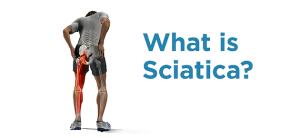Physiotherapy North York – P&C Rehab Services for Rehabilitation
Sciatica

The sciatic nerve is the largest nerve of the body that is composed of individual nerve roots which start by branching out from the spine in the lower back and combine to form the “sciatic nerve.” The sciatic nerve runs from the lower back, through the buttocks, and down the back of each leg. Sciatica refers to the pain that radiates through the course of the nerve. Typically, sciatica affects only one side of the body.
Causes
Sciatica is a symptom caused by the irritation of the nerve. The nerve may be compressed either in the spinal canal or peripherally throughout its course. The following are the leading cause for its compression:
- Intervertebral disc herniation or a slipped disc – this is the most common cause of sciatica.
- Spinal stenosis- is a narrowing of the spinal canal which can eventually compress the nerve roots of the sciatic nerve within the spinal canal.
- Spondylolisthesis- is a forward displacement of a vertebra. The abnormal position of the vertebra can put pressure on the emerging nerve roots of the sciatic nerve.
- Spondylosis- is a degenerative arthritis of the spine with associated bone spurs which can impinge the sciatic nerve.
- Piriformis syndrome- the piriformis is a small muscle of the buttocks. When it becomes tight, it can put pressure on the sciatic nerve.
- Sacroiliac joint dysfunction- the sacroiliac joint is composed of the sacrum and the pelvis, specifically the ilium. Improper functioning of SI joint may produce sciatic-like symptoms.
- Miscellaneous – tumors within the spinal canal or along the path of the sciatic nerve, fracture of the hip bone , systemic conditions like diabetes can also contribute to sciatica.
Symptoms
- Pain- shooting pain often commencing in the low back and/or buttocks, radiating down to the back of the thigh, lower leg or toes. Typically, one side of the leg is affected. Pain might increase with sneezing and/or coughing.
- Tingling and numbness in the legs – pins and needle sensation may be felt along the back of the thigh and leg as sensory fibers of the never can be compressed.
- Weakness of the lower extremities – resulting from nerve root or peripheral nerve compression.
Diagnosis
Sciatica is typically diagnosed with a subjective history and physical examination consisting of a neurological screen, movement patterns and orthopaedic tests. A positive straight leg raise test is indicative of sciatica.
Following diagnostic tests are performed to confirm the cause of sciatica:
- X Ray – degenerative changes in spine, bone spurs and decreased intervertebral joint space can be displayed on lateral and anteroposterior views of the lumbar spine.
- MRI- has the ability to detect soft tissue abnormalities such as tumors, disc bulges, nerve root compression.
- CT scan- detailed cross section images of the spinal tissue.
Treatment
- Physiotherapy/Chiropractic – a form of conservative management for sciatica. The physiotherapists or chiropractor will formulate specific treatment plans consisting of core muscle strengthening, stretching exercises, postural correction and provide educational material to avoid aggravating activities. Mechanical lumbar traction is also a useful modality to decompress the sciatic nerve.
- Pharmaceutical medicine-  such as ibuprofen , naproxen , narcotics  and anti-inflammatories are taken to control and/or alleviate symptoms.
- Steroid injection- injected locally in the affected nerve roots. Steroids suppress the symptoms by reducing the inflammation of the nerve roots and surrounding structures.
- Steroid injection- injected locally in the affected nerve roots. Steroids suppress the symptoms by reducing the inflammation of the nerve roots and surrounding structures.
The health professionals at P&C Rehabilitation Services have a lot of experience treating sciatica. If you are suffering from this condition or have any questions contact us today and book your free consultation with the physiotherapist or chiropractor.
